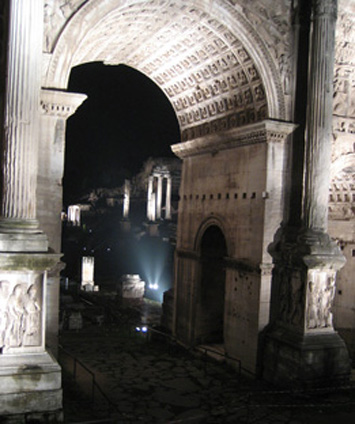Birthday Candles and Controversy
Every year on the 21st of April, Rome celebrates its own beginnings with historical re-enactments and musical events. Since the city was founded 2762 years ago it has almost constantly been the scene of political power struggles and conflict. So it seemed appropriate that, this year, the birthday celebration was itself dogged by controversy and accusations.
The highlight of the celebrations was a music and light show dubbed ‘Romagnificat’ by its organisers. To begin with, the four-lane road that Mussolini built through the Forum area was closed to traffic and, as darkness fell, the surrounding street-lights failed to blink themselves on. Thousands of people gathered in the darkness around the perimeter fences of the ancient sites between the Colosseum and piazza Venezia.
First the eerie music started up a white grand piano shone against the dark backdrop of the Trajan Markets (a semi-circular building with a double layer of arches near via dei Fori Imperiali). Then slowly, one by one, the monuments of the Forum the Basilica of Maxentius, the temple of Antonius and Faustina, the Arch of Septimus Severus, the Temple of Saturn were lit up. As far as light-shows go, this one was pretty spectacular. And, so far, nothing that could possibly stir up any trouble, surely?
The Face of Rome?
The next part of the show saw scenes from one of Italy’s most iconic films, Roma Citta’ Aperta (about Italy’s Resistance movement in the second World War), projected onto the walls of the Trajan Forum and the Trajan Markets. This too was spectacular. Unfortunately some scenes from the film show footage of Mussolini declaring Italy’s entrance into World War Two from his balcony in Rome’s piazza Venezia. This is undoubtedly a moment from the city’s rich history but some voices in the Italian press found that a two-storey high projection of Il Duce’s face onto one of Rome’s most historic buildings made them choke on their birthday cake. The next day La Repubblica reported calls from Walter Verini, the left-wing Democratic Party deputy, for the city’s right-wing mayor, Gianni Alemanno, to apologise to the Roman people for ‘insulting the city’s memory’. 
Matricide, Fratricide and Genocide
This raises an interesting question: to what extent should we edit the city’s history, wallpapering over any unsavoury characters or past events? Should we conscientiously remember the bad with the good? Maybe the Democratic Party leaders are right in finding the image of a fascist dictator inappropriate as part of a city’s birthday celebrations. It’s certainly not the image you want to send out to the rest of the world, is it? Then again, Mussolini’s story is inextricably intertwined with that of Rome.
Looking back over the city’s three millennia, its history is riddled with violence, murder, betrayal and manipulation and that was on a good day. The legend of its murky beginnings tells the story of abandoned twins, Romulus and Remus. Their mother, a king’s daughter who had inadvertently conceived them with the god Mars, left them to die on the banks of the river Tiber. All perfectly normal so far. However, they were found by a she-wolf who took them to safety. They were then brought up by shepherds and eventually founded a settlement on the banks of the river where they had been left to die many years previously. Power struggles and violence are present from the very start of Rome’s history. To ensure his own position as ruler of the new-founded city, Romulus killed his own twin.
The brutality of Roman history up until the founding of the Republic, right through to the fall of the Empire, is well documented. The Empire’s expansion was at the expense of other cultures and cities for example, 146 BC saw the city of Carthage annihilated and the majority of its one million inhabitants mercilessly killed (just 50,000 survived and were sold into slavery). This was followed by the brutal siege of Jerusalem in 70 AD, in which more than one million Jewish citizens were slaughtered. Ruthless murder was notoriously rife among the ruling elite: in 44 BC, the dictator Julius Caesar was stabbed 23 times by his senators, while the Emperor Nero had his own mother, Agrippina, killed in 59 AD.
Culture Capital
Gratuitous violence is as much a part of Rome’s history as the finer aspects of the city’s society. Of course the Romans are remembered for their inspirational architecture, as well as their innovation in constructing roads and aqueducts. Their mastery of artistic techniques and sculpture were remarkable, as well as their development of philosophy, literature and theatre. Rome is where the seed of Christianity finally took root and flourished, changing the moral mindset of western European cultures for the next two thousand years. Where promiscuity and killing had been the order of the day in the pagan society, attitudes changed as the Romans themselves adopted the new religion Rome had its first Christian emperor, Constantine I, in 306 AD and he passed an edict declaring religious tolerance in 313 AD.
Rome has always generated power-hungry, greedy politicians, but it has also been the centre of cultural revolutions. The city, as the centre of Italy and the papal seat, also played a pivotal role in Italy’s Renaissance period. It was home to Michelangelo during his adulthood and still bears his mark in the piazza del Campidoglio, St Peter’s Basilica and the Sistine Chapel as well as many other locations.
As the capital of the Italian republic (it was designated the capital of the newly-unified country in 1871), Rome has been the centre of political power, the centre of the Catholic world and the focal point of culture, arts and heritage. From the 15th century onwards, Rome has been a magnet for world-class sculptors, architects and artists.
With so many facets, Rome is genuinely a city with ‘infinite variety’, which is definitely something to celebrate on your 2762nd birthday. The only question is: do we really want to see Benito Mussolini’s face lighting up the Forum?